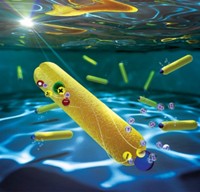Advertisement
Grab your lab coat. Let's get started
Welcome!
Welcome!
Create an account below to get 6 C&EN articles per month, receive newsletters and more - all free.
It seems this is your first time logging in online. Please enter the following information to continue.
As an ACS member you automatically get access to this site. All we need is few more details to create your reading experience.
Not you? Sign in with a different account.
Not you? Sign in with a different account.
ERROR 1
ERROR 1
ERROR 2
ERROR 2
ERROR 2
ERROR 2
ERROR 2
Password and Confirm password must match.
If you have an ACS member number, please enter it here so we can link this account to your membership. (optional)
ERROR 2
ACS values your privacy. By submitting your information, you are gaining access to C&EN and subscribing to our weekly newsletter. We use the information you provide to make your reading experience better, and we will never sell your data to third party members.
Synthesis
Nanocrystals Make Hydrogen For Days
Nickel catalyst joins forces with cadmium selenide semiconductor particles and light to convert protons to hydrogen
by Lauren K. Wolf
November 12, 2012
| A version of this story appeared in
Volume 90, Issue 46
Researchers at the University of Rochester have developed a nanocrystal-based system that continuously generates hydrogen gas from light and protons for at least two weeks (Science, DOI: 10.1126/science.1227775). The catalytic scheme joins a growing list of strategies that strive to tear apart water molecules with sunlight to produce H2, which can be used in fuel cells to produce electricity. In addition to using simple components such as Earth-abundant elements and visible light to make fuel, the researchers say their approach has the added benefit of being, to their knowledge, the longest-lasting nanoparticle-based photocatalytic system yet. To generate H2, the researchers—including graduate students Zhiji Han and Fen Qiu and chemistry professors Richard Eisenberg, Patrick L. Holland, and Todd D. Krauss—irradiate an aqueous solution of nickel(II) nitrate, ascorbic acid, and dihydrolipoic acid-coated CdSe nanocrystals with 520-nm light. The team thinks the light triggers electron transfer from the nanocrystals to a catalyst complex formed between nickel and dihydrolipoic acid. The catalyst complex then reduces protons supplied by ascorbic acid to form H2. Aside from determining the structure of the nickel catalyst, the next step for the team, Krauss says, will be to improve the water-based system’s quantum yield, which is currently 36%.





Join the conversation
Contact the reporter
Submit a Letter to the Editor for publication
Engage with us on Twitter